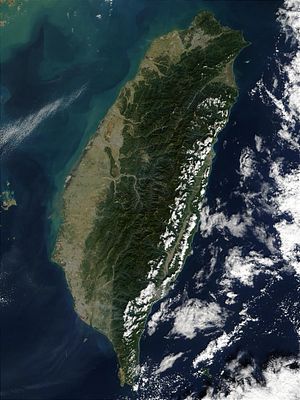On December 30, 2016, President Xi Jinping stated at the Chinese People’s Political Consultative Conference’s New Year Tea Party that “we must promote the development of cross-strait economic and social integration” and “promote cross-strait compatriots’ spiritual compatibility (心靈契合 ) for the peaceful development of cross-strait relations.” Unfortunately China’s actions toward Taiwan in 2016 were quite different from Xi’s remarks.
After U.S. President-elect Donald Trump’s phone call with Taiwan’s President Tsai Ing-wen on December 2, Beijing has taken series of actions to punish Taiwan (formally known as the Republic of China, or ROC).
First, on December 10, Chinese military aircraft flew over the East China Sea to the south of Okinawa and circled Taiwan’s air defense identification zone (ADIZ) before passing over the Bashi Channel to return to China. Later, the Chinese Air Force released photographs of its Xi’an H-6K nuclear bombers. It marked the second time China had flown long-range bombers in the region since Trump was elected. Two weeks later, China’s first aircraft carrier, the Liaoning, and five other vessels set off for the Western Pacific for an open-sea training exercise. The carrier group passed just 90 nautical miles south of Taiwan and arrived at a naval base in Hainan Province. The military signalling is clear: Beijing is undoubtedly stepping up its pressure on Tsai.
Second, on December 20, Sao Tome and Principe and the ROC severed diplomatic relations. Six days later, China established official ties with Sao Tome, the second-smallest African country with a population of less than 200,000. Taiwan’s Foreign Minister David Lee accused China of using Sao Tome and Principe’s financial woes to push its “one China” policy. Lee stated Taipei would not engage in “dollar diplomacy.” China had previously established diplomatic relations with the Gambia, another former ally of Taiwan, in spring 2016.
Third, the media has been especially vocal about cross-strait relations. China’s state-run Global Times stated that, if necessary, Beijing should prepare itself to “Lebanonize” Taiwan and “make the use of military force an actual option to realize reunification.” In September 2016, after China successfully blocked Taiwan’s participation in International Civil Aviation Organization’s General Assembly meeting in Montreal, Global Times recommended that Beijing “humiliate” Taiwan repeatedly in the future until Taiwan’s governing Democratic Progressive Party (DPP) recognizes reality.
The main goal of these drills, threats, and humiliation is to create fear and shame and turn Taiwan’s domestic public opinion against the ruling party. What Beijing does not realize is that there are consequences for its zero-sum approach toward Taiwan.
In 1970, Michel Tatu, an expert on U.S.-China-USSR relations, observed that “the surest way for any of the three [sides] to provoke the other two into collusion is to display undue aggressiveness.” Tatu’s theory is also applicable to U.S.-China-Taiwan relations today. When China acts with undue aggressiveness against Taiwan, the result has been strengthened U.S. military ties with Taiwan, such as during the 1996 missile crisis, which prompted the Washington to dispatch two aircraft carriers to the Taiwan Strait to diffuse tensions. If China continues its drills surrounding Taiwan, the result will be further military cooperation between Washington and Taipei.
In the same vein, China’s attempts to diplomatically isolate Taiwan have historically backfired as well. A once confidential U.S. State Department document released on November 22, 1971, after the ROC lost its seat in the UN to the People’s Republic of China (PRC), stated the following:
“Had both the PRC and ROC continued to be represented in the UN under the general rubric of ‘China,’ the concept of eventual reunification might have remained stronger than will now be the case….In this sense the PRC and those who voted for the Albanian Resolution at New York may have contributed greatly to increasing the pace of Taiwan’s evolution toward a separate identity.”
Since 1971, Beijing has continued to use a zero-sum method and humiliating tactics to circumscribe Taiwan’s international space. Not surprisingly, Taiwan has developed a strong self-identity in response. As the U.S. State Department predicted 45 years ago, China and supporters of the UN Resolution 2758 actually contributed to this trend.
The trend is hard to deny. A survey of National Chengchi University’s Election Study Center in December 2015 found that 59.5 percent of respondents identified themselves as Taiwanese, 33.3 percent said they were both Taiwanese and Chinese, and only 3.3 percent said Chinese. In comparison, in 1989, only 16 percent said they were Taiwanese, whereas 52 percent identified themselves as Chinese.
If Xi really wants to promote cross-strait compatriots’ goodwill for the peaceful development of cross-strait relations, his government must change old habits of dividing, suppressing, and threatening Taiwan. Instead of showing military might, Xi needs to start mending cross-straits ties. It is time to resume cross-strait communication, and search for a win-win solution in 2017.
Taiwan, meanwhile, needs also think constructively to reduce Beijing’s suspicions and “find a solution that allows both sides to maintain peaceful and stable relations,” as Tsai proposed in a year-end press conference in Taipei.
Dr. Jaw-Ling Joanne Chang is a Research Fellow at the Institute of European and American Studies, Academia Sinica

































